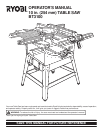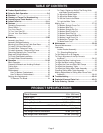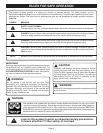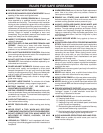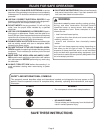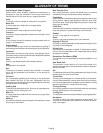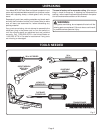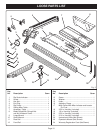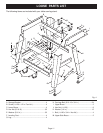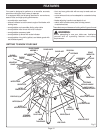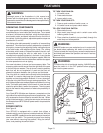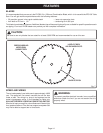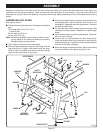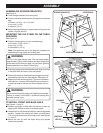
Page 5
■ BLADES COAST AFTER TURN OFF.
■ NEVER USE IN AN EXPLOSIVE ATMOSPHERE. Normal
sparking of the motor could ignite fumes.
■ INSPECT TOOL CORDS PERIODICALLY. If damaged,
have repaired by a qualified service technician at an
authorized service facility. The conductor with insulation
having an outer surface that is green with or without yellow
stripes is the equipment-grounding conductor. If repair or
replacement of the electric cord or plug is necessary, do
not connect the equipment-grounding conductor to a live
terminal. Repair or replace a damaged or worn cord
immediately. Stay constantly aware of cord location and
keep it well away from the rotating blade.
■ INSPECT EXTENSION CORDS PERIODICALLY and
replace if damaged.
■ KEEP TOOL DRY, CLEAN, AND FREE FROM OIL AND
GREASE. Always use a clean cloth when cleaning.
Never use brake fluids, gasoline, petroleum-based
products, or any solvents to clean tool.
■ STAY ALERT AND EXERCISE CONTROL. Watch what
you are doing and use common sense. Do not operate tool
when you are tired. Do not rush.
■ DO NOT USE TOOL IF SWITCH DOES NOT TURN IT
ON AND OFF. Have defective switches replaced by an
authorized service center.
■ GUARD AGAINST KICKBACK. Kickback occurs when
the blade stalls rapidly and workpiece is driven back
towards the operator. It can pull your hand into the blade
resulting in serious personal injury. Stay out of blade path
and turn switch off immediately if blade binds or stalls.
■ USE RIP FENCE. Always use a fence or straight edge
guide when ripping.
■ SUPPORT LARGE PANELS. To minimize risk of blade
pinching and kickback, always support large panels.
■ BEFORE MAKING A CUT, BE SURE ALL
ADJUSTMENTS ARE SECURE.
■ USE ONLY CORRECT BLADES. Do not use blades with
incorrect size holes. Never use blade washers or bolts that
are defective or incorrect. The maximum blade capacity of
your saw is 10 in. (254 mm).
■ AVOID CUTTING NAILS. Inspect for and remove all nails
from lumber before cutting.
■ NEVER TOUCH BLADE or other moving parts during
use.
■ NEVER START A TOOL WHEN ANY ROTATING
COMPONENT IS IN CONTACT WITH THE WORKPIECE.
■ DO NOT OPERATE THIS TOOL WHILE UNDER THE
INFLUENCE OF DRUGS, ALCOHOL, OR ANY
MEDICATION.
■ GROUND ALL TOOLS. If tool is equipped with three-
prong plug, it should be plugged into a three-hole electrical
receptacle.
■ WHEN SERVICING use only identical Ryobi replacement
parts. Use of any other parts may create a hazard or
cause product damage.
■ REMOVE ALL FENCES AND AUXILIARY TABLES
before transporting saw. Failure to do so can result in an
accident causing possible serious personal injury.
■ ALWAYS USE BLADE GUARD, RIVING KNIFE, AND
ANTI-KICKBACK PAWLS on all "through-sawing" op-
erations. Through-sawing operations are those in which
the blade cuts completely through the workpiece as in
ripping or crosscutting. Keep the blade guard down, the
anti-kickback pawls down, and the riving knife in place
over the blade.
■ ALWAYS SECURE WORK firmly against rip fence or
miter fence.
■ ALWAYS USE A PUSH STICK FOR RIPPING NARROW
STOCK. A push stick is a device used to push a workpiece
through the blade instead of using your hands. Size and
shape can vary but the push stick must always be nar-
rower than the workpiece to prevent the push stick from
contacting the saw blade. When ripping narrow stock,
always use a push stick, so your hand does not come
close to the saw blade. Use a featherboard and push
blocks for non-through cuts.
■ NEVER perform any operation "freehand" which means
using only your hands to support or guide the workpiece.
Always use either the rip fence or miter fence to position
and guide the work.
■ NEVER stand or have any part of your body in line with the
path of the saw blade.
■ NEVER reach behind, over, or within three inches of the
blade or cutter with either hand for any reason.
■ MOVE THE RIP FENCE out of the way when crosscutting.
■ NEVER use rip fence as cutoff gage when crosscutting.
■ NEVER attempt to free a stalled saw blade without first
turning the saw OFF and disconnecting the saw from the
power source.
■ PROVIDE ADEQUATE SUPPORT to the rear and sides
of the saw table for wide or long work pieces. Use a sturdy
"outrigger" support if a table extension more than 24
inches long is attached to the saw.
■ AVOID KICKBACKS (work thrown back toward you) by:
A. Keeping blade sharp.
B. Keeping rip fence parallel to the saw blade.
C. Keeping riving knife, anti-kickback pawls, and blade
guard in place and operating.
D. Not releasing the work before it is pushed all the way
past the saw blade using a push stick.
E. Not ripping work that is twisted or warped or does not
have a straight edge to guide along the fence.
■ AVOID AWKWARD OPERATIONS AND HAND POSI-
TIONS where a sudden slip could cause your hand to
move into the cutting tool.
RULES FOR SAFE OPERATION



